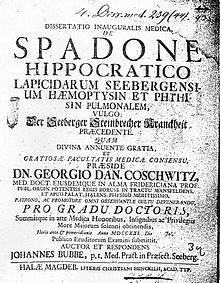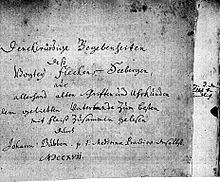Johannes Bubbe
Johannes Bubbe (born March 23, 1687 in Seebergen , † December 19, 1741 in Gotha ) was a local researcher and doctor.
Bub (b) e was born as the son of the organist and maid servant Johannes Daniel Bube (err. 1658 in Rudisleben -1705 in Seebergen) and his wife Maria Dorothea, b. Töpfer (err. 1662 in Blankenhain -1739 in Seebergen), born as one of six children from this marriage. "On 23rd Martius a son was baptized to the organist here, H. Joh Daniel Buben, the witness was Hans Keil junior, after which the child Johannes was given".
The parents married in Rudisleben in 1682, but the marriage was registered in Seebergen. Johannes' six siblings were Johann Heinrich (* 1683; † 1683), Eva Barbara (* 1685; † 1740), Barbara Maria (* 1689), Anna Maria (* 1692; † 1749), Johann Matthias (* 1694; † 1741) and Maria Dorothea (* 1697). Johann Matthias was seven years younger than Johannes and also became organist and school clerk in Seebergen in 1720. The family lived in the school house rebuilt in 1610 within the churchyard walls.
On June 20, 1707 , he enrolled at the University of Jena as a medical student. In 1721 the dissertation was carried out in Halle on the Seeberg stone breaker disease . He then practiced in Seebergen until 1728 and married Catharina Magdalena Ballstedt on January 26, 1728 in Gotha. In 1741 he died as a widower in Gotha.
Life's work
Already in his youth, Bubbe discovered that the workers in the Seeberg sandstone quarry were suffering from lung diseases. When he settled as a doctor in his home village after completing his studies, he had to experience that many sick people in the village who worked as stone breakers, sand collectors or sculptors died much earlier than those who had other work. The Seeberg death register lists twelve stone breakers between 1680 and 1730 who were between 33 and 50 years old. However, it can be assumed - the cause of death was not recorded - that this included victims of the quarries and not only those with lung disease.
Bubbe attributed the lung diseases to the fact that the inhaled fine dust settled in the lungs. Other causes made the healing more difficult: excessive alcohol consumption (beer and schnapps) in cold vaults, hard work in the quarry, sulphurous air and influences from the environment and the seasons. His therapies seem a bit adventurous today: bloodletting, baths and rubs as well as the administration of herbal mixtures of medicinal herbs, beer and butter. A recipe quoted in his dissertation reads as follows:
- Take laugh garlic , centaury , Edelgamanderkraut , to Hirschzunge , Andornkraut white Erdrauchkraut , sorrel , strawberry herb Joseph herb , borage , wormwood , Roman sage , lemon balm , lungwort , liver herb , Veronica , chamomile , Betonienkraut , Sanickelkraut , gold lacquer flower , orris root , figwort herbs , fresh Pimpinell roots , lovage , very good rhubarb , fennel seeds , anise , citrated liquorice bark essence , cherry bark , dry, cut up and crush the ingredients and put them in a sleeve to half a bucket of beer. These drugs are put in a sack and nailed to the bottom of the barrel so that they are not picked up by the beer poured over it. When this has happened, fresh but fully fermented beer is poured in with it. The herbs are changed for three days to extract the healing power. When that's over, take a quarter of a measure in the morning and evening, warm it up, add unsalted butter and drink it up. During the rest of the day, you take a sip of the beer remedy, but without always warming it up and adding butter.
Bubbe commented on the recipe himself by writing:
- I will leave it to the goodness of the interested reader what he or she will think of this recipe. But I testify with all credibility that I have seen and everyone can see how people who were emaciated and thought lost were restored by this simple means.
Bubbe was also busy as a local researcher, which can be seen from an entry in the Arnstadt archive that identifies him as a participant in the excavation of skeletons at the Wachsenburg .
Works
- DISSERTATIO INAUGURALIS MEDICA DE SPADONE HIPPOCRATICO LAPIDARUM SEEBERGENSIUM HAEMOPTYSIN ET pHTISIN PULMONALEM VULGO: THE SEEBERGER STONE CRUSHER DISEASE PRAECEDENTE (his doctoral thesis). It was translated into German in 1968 by the 25-year-old medical student Michael Kiesel.
Honors
- In the district of Seebergen in the community of Drei Gleichen, a street is named after Bubbe, but in the spelling Dr.-Bube-Straße .
- In recognition of Bubbe's research, who presented the oldest documentary evidence in Thuringia on the subject of “Dangerous working conditions and consequences for the life and health of employees” with his dissertation, the max. 20,000 DM Thuringian labor protection award with the name Johannes Bube (in this spelling) provided. A stonemason company in Jena received the award in 2000.
Others
Bubbe signed a trading book from Seebergen in 1717 with Johann Bubben pt Mdezinae Practico there (see picture).
Web links
Individual evidence
- ↑ The date of birth was usually a few days before the date of baptism, which was regularly entered in the church registers
- ^ Church book St. Georg Seebergen 1646–1736, baptisms, p. 241, no. 9
swell
- Local history of the Seebergen community, managed by Ingeburg Wolf
| personal data | |
|---|---|
| SURNAME | Bubbe, Johannes |
| ALTERNATIVE NAMES | Jack, Johannes |
| BRIEF DESCRIPTION | German doctor and local researcher |
| DATE OF BIRTH | March 23, 1687 |
| PLACE OF BIRTH | Seamounts |
| DATE OF DEATH | December 19, 1741 |
| Place of death | Gotha |

